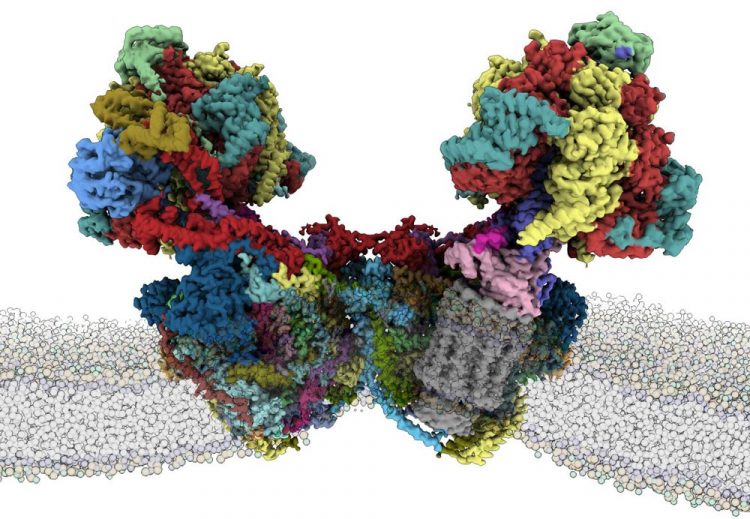Structure of a mitochondrial ATP synthase

This is an everview of the E. gracilis ATP synthase dimer. Credit: A. Muhleip
Alexander Mühleip from Amunts lab used the single-cell photosynthetic organism Euglena gracilis, which belongs to a phylum that also includes human parasites, to extract the mitochondrial ATP synthase. Its structure was then determined using cryo-EM, allowing the reconstruction of the atomic model.
The high resolution of the cryo-EM density map allowed identification of 29 different protein subunits and 25 cardiolipin molecules. Some of the cardiolipins appear to modulate the critical channel for proton transfer that fuels the machine, which is the first evidence for their direct involvement.
The model shows that the Euglena mitochondrial ATP synthase is highly divergent with 13 protein subunits being specific to this system. The new subunits contribute to the formation of dimers glued by lipids, providing experimental evidence that the key functional property of membrane curvature induction has likely occurred independently in evolution.
Furthermore, a membrane-embedded subcomplex was found at the periphery of the ATP synthase, displacing the membrane. Sarah McComas performed molecular dynamics simulations supporting that the newly found subcomplex contributes to the membrane curvature.
The atomic model of the mitochondrial ATP synthase with native lipids provides a new perspective for its functional analysis. The different type of molecular organization of this essential energy production machinery re-establishes the defining features of the complex and opens the door for reconstructing the evolution of the mitochondrial ATP synthase. Finally, identified similarities to the human parasites provide a new perspective for a therapeutic exploration.
###
About SciLifeLab
SciLifeLab is a joint enterprise of Swedish universities, that aims to provide frontline technologies for the Swedish academic community and develop cutting-edge research programs. Situated on the expanding Stockholm biomedical campus, SciLifeLab offers the opportunity to work in an internationally competitive and synergistic environment. The center combines technical expertise with advanced knowledge of translational medicine and molecular bioscience.
Media Contact
More Information:
http://dx.doi.org/10.7554/eLife.51179All latest news from the category: Life Sciences and Chemistry
Articles and reports from the Life Sciences and chemistry area deal with applied and basic research into modern biology, chemistry and human medicine.
Valuable information can be found on a range of life sciences fields including bacteriology, biochemistry, bionics, bioinformatics, biophysics, biotechnology, genetics, geobotany, human biology, marine biology, microbiology, molecular biology, cellular biology, zoology, bioinorganic chemistry, microchemistry and environmental chemistry.
Newest articles

Trotting robots reveal emergence of animal gait transitions
A four-legged robot trained with machine learning by EPFL researchers has learned to avoid falls by spontaneously switching between walking, trotting, and pronking – a milestone for roboticists as well…

Innovation promises to prevent power pole-top fires
Engineers in Australia have found a new way to make power-pole insulators resistant to fire and electrical sparking, promising to prevent dangerous pole-top fires and reduce blackouts. Pole-top fires pose…

Possible alternative to antibiotics produced by bacteria
Antibacterial substance from staphylococci discovered with new mechanism of action against natural competitors. Many bacteria produce substances to gain an advantage over competitors in their highly competitive natural environment. Researchers…





















